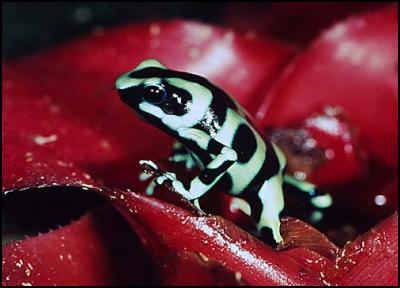Intrigue Over Poison Arrow Frog Trade
Intrigue Over Poison Arrow Frog
Trade

Cambridge, UK, 1 April 2010There are suspicious discrepancies in the numbers of South American poison arrow frogs reported in international trade, according to a new study published in the journal Biodiversity and Conservation.
Vincent Nijman of the Oxford Wildlife Trade Research Group and Chris Shepherd of TRAFFIC Southeast Asia analysed international trade records reported to CITES (the Convention on International Trade in Endangered Species of Wild Fauna and Flora) between 2004 and 2008 in poison arrow frogs species native to South and Central America.
They uncovered a number of discrepancies in the data. Kazakhstan, for example, reported no trade whatsoever in poison arrow frogs, but between 2004 and 2008, Thailand claimed to have imported more than 2,500 originating from Kazakhstan, via Lebanon.
“It is probably highly significant that exports from Kazakhstan to Thailand went via Lebanon, a non-Party to CITES who, therefore, would be under no obligation to report the transfer,” said Chris Shepherd, Senior Programme Officer with TRAFFIC Southeast Asia.
“Further investigations should be carried out into the reasons why this particular route was reportedly used and authorities should also be alerted to the possibility that specimens declared as captive-bred could be wild-caught and are being laundered into the international trade”.
Many poison arrow frogs are brightly coloured to act as a warning to predators, which has led to them becoming popular as exotic pets in Europe and North America, and increasingly in Asia. They are so-called because of their toxic skin secretions, used by indigenous people in South America as poison on the tips of blow-darts.
“The popularity of poison arrow frogs as pets has led to some species being over-harvested in the wild, putting them at risk,” said Nijman.
In total, the analysis found that more than 63,000 poison arrow frogs of 32 species were traded internationally between 2004 and 2008. For 21 species the majority of individuals were reported as captive-bred. Around a fifth were destined for markets in AsiaJapan, Thailand and Taiwanwhere keeping exotic pets is becoming increasingly popular.
Five of the species reported in trade are regarded by IUCN, the International Union for Conservation of Nature, as at risk of global extinction. They include the Golden Poison Frog Phyllobates terribilis, an Endangered species known only from tiny areas on the Pacific coast of Colombia. Of 342 reported in trade, 287 were claimed to have been captive-bred, 200 of them in Kazakhstan.
Similarly, 100 of the 213 Epipedobates tricolor reported in trade—a species known from just seven localities in Ecuador—were said to be captive-bred in Kazakhstan, while 200 of the 220 reported captive-bred Black-legged Poison Frogs Phyllobates bicolor, a Near Threatened species, were also claimed to have originated in the Central Asian country.
The authors recommend better accuracy in reporting and investigations into the origin of pets in international trade to ensure wild-caught specimens are not being laundered under the guise of being captive-bred.
Last month, representatives of 175 member governments to CITES met in Doha, Qatar and voted for stronger controls over the international trade in Central American treefrogs, and effectively banned all commercial trade in Kaiser’s Spotted Newts from Iran.
“While a CITES listing will
help both the treefrogs and the newt threatened by trade, as
the poison arrow frog case demonstrates, a listing is only
useful if it is properly adhered to,” said Nijman.
Notes
All
species of poison arrow frog (genera Dendrobates,
Phyllobates, Epipedobates and
Cryptophyllobates) are listed in Appendix II of
CITES, thereby regulating international commercial trade in
the species.
The paper by Vincent Nijman and Chris R. Shepherd The role of Asia in the global trade in CITES II-listed poison arrow frogs: hopping from Kazakhstan to Lebanon to Thailand and beyond is published in the journal Biodiversity and Conservation. It is available online at: http://www.springerlink.com/content/b013x81t3306565k/fulltext.pdf
ENDS


 Global Jews for Palestine: Jewish Organisations' Passover Statement, After 40 Days Of Starvation
Global Jews for Palestine: Jewish Organisations' Passover Statement, After 40 Days Of Starvation APEC: Stronger Immunization Policies Needed As Vaccine Confidence Falls
APEC: Stronger Immunization Policies Needed As Vaccine Confidence Falls 350.org: Indigenous Groups From The Pacific, Brazil & Canada Hand Demands To COP30 Presidency To End Fossil Fuels
350.org: Indigenous Groups From The Pacific, Brazil & Canada Hand Demands To COP30 Presidency To End Fossil Fuels Conservation International: Conservation International Expedition Reveals Ecosystem Recovery In Tokelau
Conservation International: Conservation International Expedition Reveals Ecosystem Recovery In Tokelau UN Special Procedures - Human Rights: UN Expert Urges States To Finance Inclusive And Sustainable Development, Not A War Economy
UN Special Procedures - Human Rights: UN Expert Urges States To Finance Inclusive And Sustainable Development, Not A War Economy Amnesty International Aotearoa NZ: Global - Recorded Executions Highest Since 2015
Amnesty International Aotearoa NZ: Global - Recorded Executions Highest Since 2015